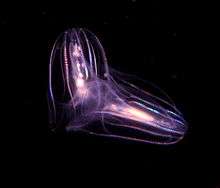Coelenterata
Coelenterata is a term encompassing the animal phyla Cnidaria (coral animals, true jellies, sea anemones, sea pens, and their allies) and Ctenophora (comb jellies). The name comes from Ancient Greek: κοῖλος, romanized: koilos, lit. 'hollow' and ἔντερον, enteron, 'intestine', referring to the hollow body cavity common to these two phyla.[1][2] They have very simple tissue organization, with only two layers of cells (external and internal), and radial symmetry. Some examples are corals, which are typically colonial, and hydra, jelly fish and sea anemones which are solitary. Coelenterata lack a specialized circulatory system relying instead on diffusion across the tissue layers.
| Coelenterates | |
|---|---|
 | |
| Comb jellies (Beroe spp.) | |
| Scientific classification | |
| Kingdom: | |
| Subkingdom: | |
| Phylum: | Coelenterata |
| Phyla | |
Characteristics
All coelenterates are aquatic, mostly marine. The bodyform is radially symmetrical, diploblastic and does not have a coelom. The body has a single opening, the hypostome, surrounded by sensory tentacles equipped with either nematocysts or colloblasts to capture mostly planktonic prey. These tentacles are surrounded by a spacious cavity called the gastrovascular cavity or coelenteron. Digestion is both intracellular and extracellular. Respiration and excretion are accomplished by simple diffusion. A network of nerves is spread throughout the body. Many Cnidaria exhibit polymorphism, wherein different types of individuals are present in a colony for different functions. These individuals are called Zooids. These animals generally reproduce asexually by budding, though sexual reproduction does occur in some groups.
History of classification
The scientific validity of the term coelenterate is currently disputed, as the Cnidaria and Ctenophora have less in common than previously assumed.[3] Coelentera may only be monophyletic if both Placozoa and Bilateria are included.[4] In particular, the phylogenetic position of Ctenophora is controversial; it was first considered a sub-group of coelenterata but Hyman regarded it as a separate phylum.[4][5] Some researchers suggest that Coelenterata is not monophyletic, and therefore any group containing Cnidaria and Ctenophora but excluding other phyla would be paraphyletic. However, some genomic studies have found support for monophyletic coelenterates.[6][7] Despite this uncertainty, the term coelenterate is still used in informal settings to refer to the Cnidaria and Ctenophora.
Complicating the issue is the 1997 work of Lynn Margulis (revising an earlier model by Thomas Cavalier-Smith) that placed the Cnidaria and Ctenophora alone in the branch Radiata within Eumetazoa.[8] (The latter refers to all the animals except the sponges, Trichoplax, and the still poorly understood Mesozoa). Neither grouping is accepted universally,[9] however, both are commonly encountered in taxonomic literature.[3][6]
References
- "coelenterate - definition of coelenterate in English | Oxford Dictionaries". Oxford Dictionaries | English. Retrieved 25 February 2017.
- "Definition of COELENTERATE". www.merriam-webster.com. Merriam-Webster. Retrieved 25 February 2017.
- Dunn, Casey W.; Leys, Sally P.; Haddock, Steven H.D. (May 2015). "The hidden biology of sponges and ctenophores". Trends in Ecology & Evolution. 30 (5): 282–291. doi:10.1016/j.tree.2015.03.003. PMID 25840473.
- Pisani, Davide; Pett, Walker; Dohrmann, Martin; Feuda, Roberto; Rota-Stabelli, Omar; Philippe, Hervé; Lartillot, Nicolas; Wörheide, Gert (2015-12-15). "Genomic data do not support comb jellies as the sister group to all other animals". Proceedings of the National Academy of Sciences. 112 (50): 15402–15407. Bibcode:2015PNAS..11215402P. doi:10.1073/pnas.1518127112. ISSN 0027-8424. PMC 4687580. PMID 26621703.
- Whelan, Nathan V.; Kocot, Kevin M.; Moroz, Leonid L.; Halanych, Kenneth M. (2015-05-05). "Error, signal, and the placement of Ctenophora sister to all other animals". Proceedings of the National Academy of Sciences. 112 (18): 5773–5778. Bibcode:2015PNAS..112.5773W. doi:10.1073/pnas.1503453112. ISSN 0027-8424. PMC 4426464. PMID 25902535.
- Philippe, Hervé; Derelle, Romain; Lopez, Philippe; Pick, Kerstin; Borchiellini, Carole; Boury-Esnault, Nicole; Vacelet, Jean; Renard, Emmanuelle; Houliston, Evelyn (April 2009). "Phylogenomics Revives Traditional Views on Deep Animal Relationships". Current Biology. 19 (8): 706–712. doi:10.1016/j.cub.2009.02.052. ISSN 0960-9822. PMID 19345102.
- Nosenko, Tetyana; Schreiber, Fabian; Adamska, Maja; Adamski, Marcin; Eitel, Michael; Hammel, Jörg; Maldonado, Manuel; Müller, Werner E. G.; Nickel, Michael (2013-04-01). "Deep metazoan phylogeny: When different genes tell different stories". Molecular Phylogenetics and Evolution. 67 (1): 223–233. doi:10.1016/j.ympev.2013.01.010. PMID 23353073.
- Margulis, Lynn and Karlene V. Schwartz, 1997, Five Kingdoms: An Illustrated Guide to the Phyla of Life on Earth, W.H. Freeman & Company, ISBN 0-613-92338-3
- "Taxonomy browser (Eumetazoa)". www.ncbi.nlm.nih.gov.